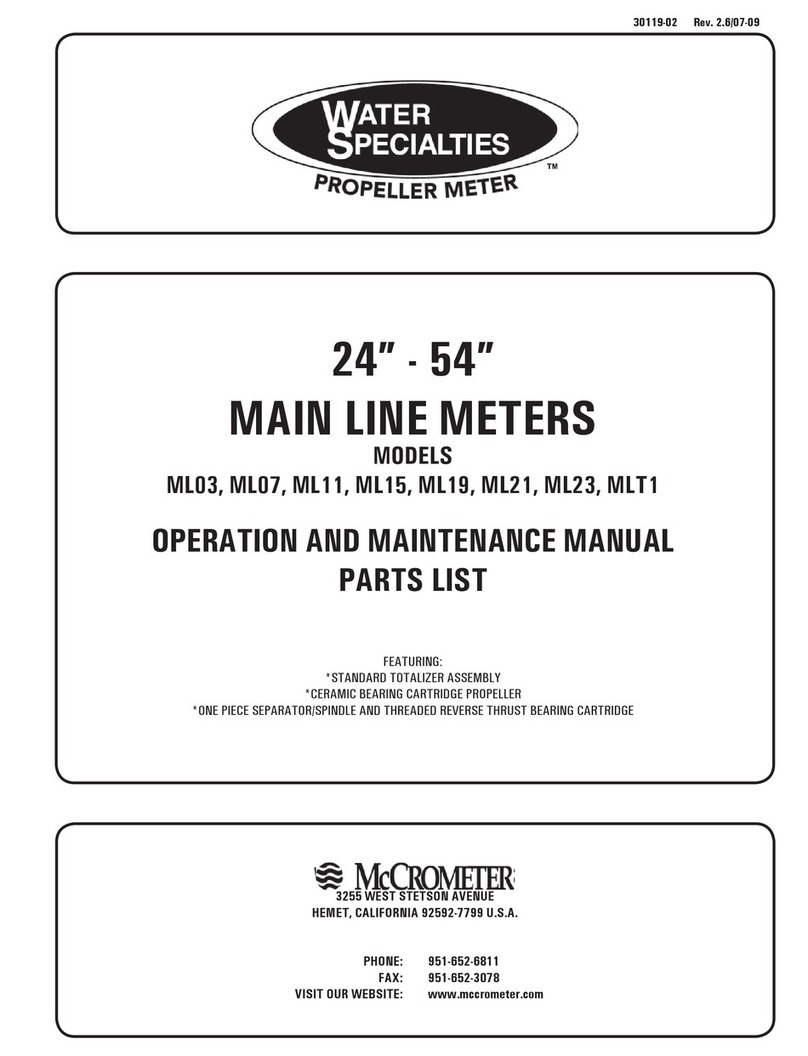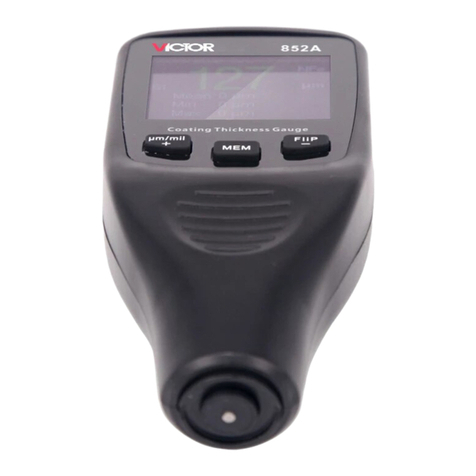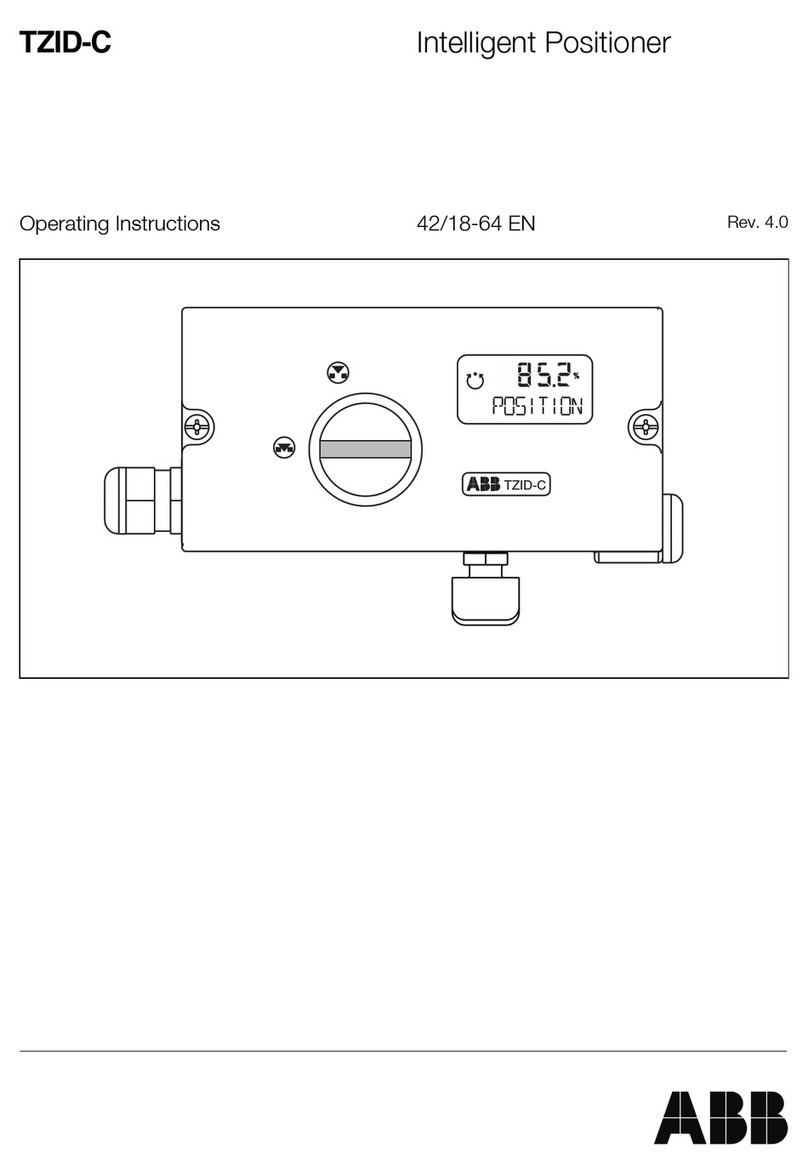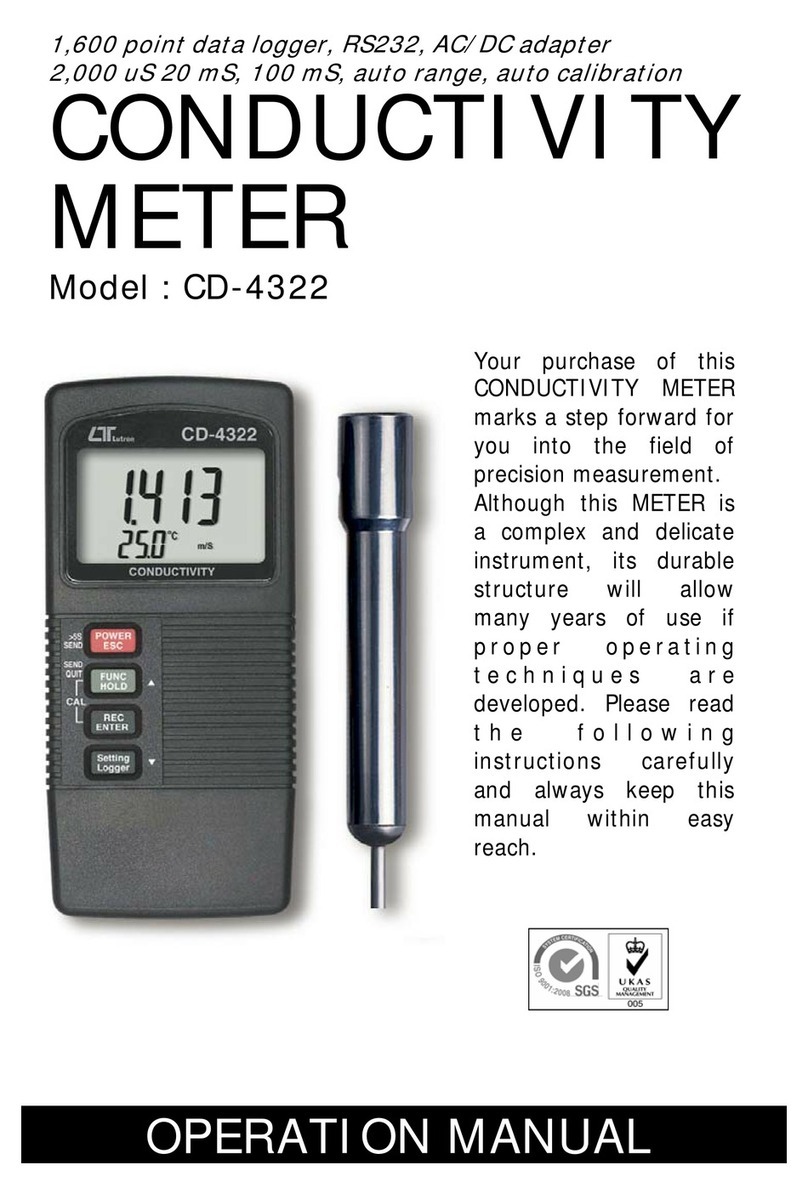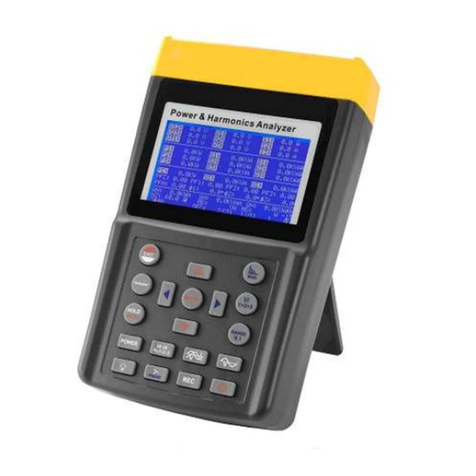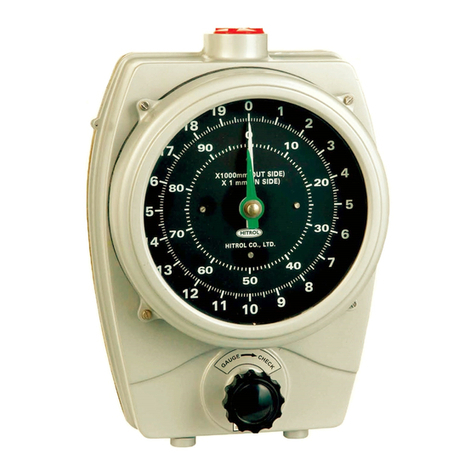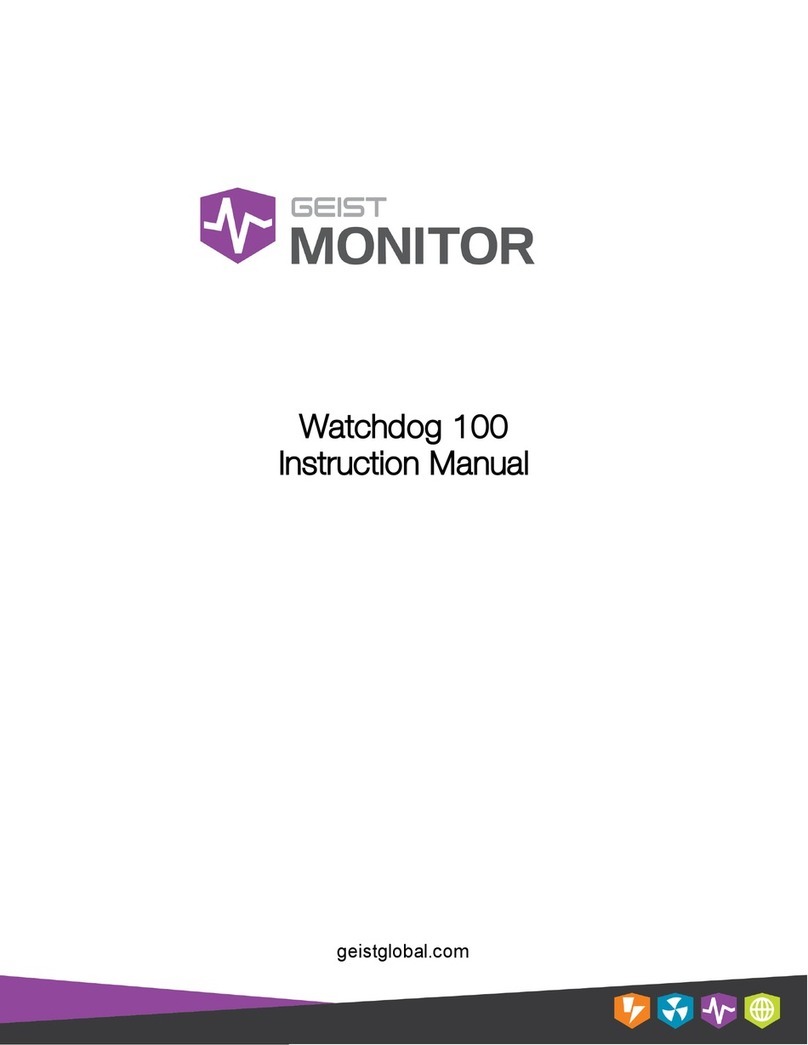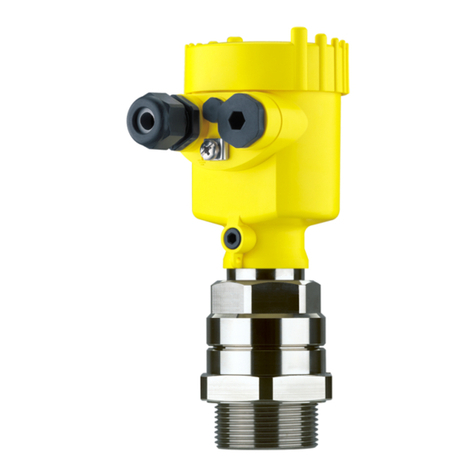Water Specialties LP04D Installation guide

30119-16 Rev. 4.9/07-09
4” STRAP-ON
ELECTRONIC
LOW PRESSURE METERS
MODEL
LP04D, LP12D, LP22D
OPERATION AND MAINTENANCE MANUAL
PARTS LIST
FEATURING:
*CERAMIC BEARING CARTRIDGE
*STAINLESS STEEL SADDLE & U-BANDS
*MODEL FC101 FLOWCOM REGISTER INDICATOR-TOTALIZER
*ONE PIECE SEPARATOR/SPINDLE AND THREADED REVERSE THRUST BEARING CARTRIDGE
3255 WEST STETSON AVENUE
HEMET, CALIFORNIA 92545 U.S.A.
PHONE:
FAX:
VISIT OUR WEBSITE:
951-652-6811
951-652-3078
www.mccrometer.com

30119-16 Rev. 4.9/07-09
2
Copyright © 2000-2007 McCrometer. All printed material should not be changed or altered without permission of McCrometer.
The published technical data and instructions are subject to change without notice. Contact your McCrometer representative for current technical data and instructions.
WARRANTY
This Warranty shall apply to and be limited to the original purchaser consumer of any McCrom-
eter product. Meters or instruments defective because of faulty material or workmanship will
be repaired or replaced, at the option of McCrometer, free of charge, FOB the factory in Hemet,
California, within a period of one (1) year from the date of delivery.
Repairs or modifications by others than McCrometer or their authorized representatives shall
render this Warranty null and void in the event that factory examination reveals that such repair
or modification was detrimental to the meter or instrument. Any deviations from the factory
calibration require notification in writing to McCrometer of such recalibrations or this Warranty
shall be voided.
In case of a claim under this Warranty, the claimant is instructed to contact McCrometer, 3255
W. Stetson Ave., Hemet, California 92545, and to provide an identification or description of the
meter or instrument, the date of delivery, and the nature of the problem.
The Warranty provided above is the only Warranty made by McCrometer with respect to its
products or any parts thereof and is made expressly in lieu of any other warranties, by course of
dealing, usages of trade or otherwise, expressed or implied, including but not limited to any implied
warranties of fitness for any particular purpose or of merchantability under the uniform commer-
cial code. It is agreed this Warranty is in lieu of and buyer hereby waives all other warranties,
guarantees or liabilities arising by law or otherwise. Seller shall not incur any other obligations
or liabilities or be liable to buyer, or any customer of buyer for any anticipated or lost profits,
incidental or consequential damages, or any other losses or expenses incurred by reason of the
purchase, installation, repair, use or misuse by buyer or third parties of its products (including
any parts repaired or replaced); and seller does not authorize any person to assume for seller any
other liability in connection with the products or parts thereof. This Warranty cannot be extended,
altered or varied except by a written instrument signed by seller and buyer.
This Warranty gives you specific legal rights, and you may also have other rights which vary from
state to state.
McCrometer reserves the right to make improvements and repairs on product components which
are beyond the Warranty period at the manufacturer’s option and expense, without obligation to
renew the expired Warranty on the components or on the entire unit. Due to the rapid advancement
of meter design technology, McCrometer reserves the right to make improvements in design and
material without prior notice to the trade.
All sales and all agreements in relation to sales shall be deemed made at the manufacturer’s
place of business in Hemet, California and any dispute arising from any sale or agreement shall
be interpreted under the laws of the State of California.

30119-16 Rev. 4.9/07-09
3
ELECTRONIC LOW PRESSURE METER
INDEX
I. UNCRATING
II. INSTALLATION
1. Flanged Tube Meters
2. Plain End Tube Meters
3. Strap-On Saddle Meters
A. Align
B. Scribe
C. Cut Out
D. Straightening Vanes
E. Meter Assembly
III. OPERATION AND MAINTENANCE MANUAL
IV. METER SADDLE ASSEMBLY
V. WORKING AREA
VI. DISASSEMBLY & INSPECTION
1. Propeller Removal
2. Reverse Thrust Bearing Cartridge
3. Water Lubrication
4. Ceramic Bearing Cartridge
5. Spindle Ceramic Sleeve
6. Separator/Support Spindle Assembly
VII. REASSEMBLING METER
1. Propeller Installation
2. Thrust Bearing Cartridge Assembly
3. Propeller Bearing
VIII. SENSOR & FC101 DIGITAL INDICATOR-TOTALIZER
1. FC101 Digital Indicator
2. FC101 Removal
3. Sensor Housing
4. Replacing Sensor Housing
5. Inspect O-ring
6. Lithium Battery
7. FC101 Digital Indicator-Totalizer
IX. PREPARATION PRIOR TO INSTALLING METER
1. Propeller Assembly
2. FC101
3. Meter Saddle O-ring
X. ORDERING PARTS OR RETURN TO FACTORY
ELECTRONIC LOW PRESSURE METER
INSTALLATION
I. UNCRATING. When uncrating the meter, any damage due
to rough or improper handling should be reported to the
transportation firm and McCrometer. If, for any reason,
it is determined that the unit or parts of the unit should
be returned to the factory, please contact McCrometer for
clearance prior to shipment. Each unit must be properly
crated to prevent any further damage. The factory as-
sumes no responsibility for equipment damage in return
shipment due to improper packaging. The shipping crate
contains the following items:
Low Pressure Meter Assembly with FC101.................1
Mounting Equipment as required ...................................-
Operation and Maintenance Manual .............................1
Tool T-2402X-1 ..........................................................1
II. INSTALLATION of McCrometer Low Pressure Electronic
Meters varies depending upon the type and model of meter
selected for each application. The meter must have a
full flow of liquid for proper accuracy. Fully opened gate
valves, fittings, or other obstructions that tend to set
up flow disturbances should be a minimum of ten pipe
diameters upstream and two pipe diameters downstream
from the meter. Installations with less than ten pipe
diameters of straight pipe require straightening vanes.
Meters with straightening vanes require at least five pipe
diameters upstream and one pipe diameter downstream
from the meter. The meter installations fall into three
basic categories:
1. FLANGED TUBE METERS can be installed exactly
as you would install any short length of flanged pipe.
Flanged ends are standard pattern and drilling for any
meter size.
2. PLAIN END TUBE METERS can be installed similar
to replacing a short length of plain end pipe in the line by
either welding or using one of a variety of pipe couplings
available. Note: Meter saddle assembly (#26) should be
removed before welding. (See step IV.)
3. STRAP-ON SADDLE METERS can be installed on
an existing pipeline by cutting a hole of proper size in the
existing pipeline. The installation steps outlined below
should be followed carefully to achieve proper mounting
of the meter:
A. ALIGN the cutout template in the desired position for
the meter on the pipe. Make certain that the center line
of the pipe and the center line marked on the template
are parallel with each other.
B. SCRIBE the pipe along the line specified for your
meter size cutout.
C. CUT OUT the section of pipe within the scribed line
and remove all burrs, slag, and rough edges from the inside
and outside of the cutout section.

30119-16 Rev. 4.9/07-09
4
D. STRAIGHTENING VANES are recommended when
there are less than ten pipe diameters of straight pipe
(no fittings or obstructions) directly upstream from the
meter location. Straightening vanes are available from the
factory. (See Straightening Vane Installation Instructions
if required for your meter.)
E. METER ASSEMBLY should be placed on the pipe
with the propeller nose facing the upstream flow in the
pipe. Use care when installing the meter not to damage
the propeller as it passes through the saddle opening.
Make certain that the meter saddle is correctly positioned
and centered in the cutout opening before attaching the
meter to the pipe. WARNING: Customers are warned
that the U-Bolt nuts are to be tightened evenly to approxi-
mately 30 foot pound torque. This is sufficient to seal
the saddle to the pipeline. Additional tightening may be
required to seal the saddle on rough or irregular pipe.
ELECTRONIC LOW PRESSURE METER
OPERATION AND MAINTENANCE MANUAL
III. MCCROMETER products have been carefully designed to
be as maintenance free as possible. Periodic preventive
maintenance, however, is highly recommended and should
be practiced according to schedule to assure continuous
accuracy and trouble-free performance of your propeller
meters. The maintenance and inspection procedure can
also be used as a guide to locating a problem in the unit
that may be the cause of abnormal meter operation.
Routine preventative maintenance should be performed
on all meters, which includes cleaning and an inspection
of the propeller and its bearing. The interval between
inspections depends on the water quality and the usage
of the meter. The initial inspection should be performed
after one to two years of service, to determine the period
between future inspections. After five to ten years, the
complete meter should be inspected to ensure years of
dependable service.
IV. METER SADDLE ASSEMBLY (#26) should be removed
from the service line by removing the U-strap nuts (#23)
and lifting up the rear (downstream) portion of the meter
saddle (#26), carefully pulling the assembly back (down-
stream) and up at the same time to allow the propeller
(#2) to clear the cutout opening in the pipeline so the
meter can be lifted free. Inspect the meter saddle O-ring
(#22) for any sign of damage and replace if necessary.
Replace the meter assembly (#26) with a dummy cover
saddle if the service line is to remain in operation.
V. WORKING AREA chosen for disassembly and reassembly
of the meter components should be clean to reduce the
chance of dust or dirt particles being introduced into the
propeller area.
VI. DISASSEMBLY AND INSPECTION OF METER includes
cleaning the propeller assembly (#1), ceramic sleeve bear-
ing (#8), separator assembly (#12), and drive magnet
(#9).
1. PROPELLER REMOVAL can be accomplished by
first removing the thrust bearing cartridge assembly (#5).
Loosen the set screw (#27) in the side of the nose of
the propeller. Remove the thrust bearing cartridge (#5)
by turning it counterclockwise while holding the propeller
in place.
2. REVERSE THRUST BEARING CARTRIDGE (#6)
must now be removed. Turn the propeller (#2) so that
the allen wrench clearance hole is lined up with the set
screw in the side of the reverse thrust bearing cartridge
(#6). The location of the set screw is marked by a
small hole drilled in the face of the reverse thrust bearing
cartridge. With a 5/64 inch allen wrench, loosen the set
screw (#7) in the reverse thrust bearing cartridge (#6)
two to three turns, which will allow the cartridge to be
unscrewed without damaging the spindle thread. Note:
If the bearing area appears to be clogged with dirt or
sediment, making it difficult to locate the set screw (#7)
or to allow the allen wrench to fit into the set screw
socket, then the bearing area should be flushed out with
water. Insert Tool T-2402X-1 into the propeller through
the threaded nose. The tabs in the tool should engage
in the screwdriver slot in the end of the reverse thrust
bearing cartridge (#6). Remove the propeller assembly
(#1) and reverse thrust bearing cartridge (#6) by turning
Tool T-2402X-1 counterclockwise unscrewing the reverse
thrust bearing cartridge (#6) from the spindle (#12). The
propeller assembly with reverse flow cartridge will now
slide off the spindle. WARNING: If the reverse thrust
cartridge does not unscrew easily, it may be because
the set screw was not unscrewed enough. If unscrew-
ing the reverse flow cartridge is continued with the set
screw binding on spindle thread, damage to thread could
occur.
3. WATER LUBRICATION of the ceramic sleeve bear-
ing (#8) is achieved by means of two openings in the end
of the thrust bearing cartridge (#5) which allow air to be
purged from the bearing area. These should be cleared
of any foreign material by running a small wire through
the holes on either side of the screwdriver slot.
4. CERAMIC BEARING CARTRIDGE (#8) and drive
magnet (#9) should be cleaned of any foreign material and
inspected for damage. Using a bottle brush, thoroughly
clean the ceramic bearing surface (#8) and the magnet
inside diameter (#9). After cleaning the propeller, flush
the inside out with water. The outside surfaces of the
propeller should also be cleaned to assure a smooth,
unrestricted flow across the surface of the propeller. Do
not use an oil based solvent in cleaning, as damage to
the assembly could occur.
5. SPINDLE CERAMIC SLEEVE and the O.D. or
surface of the separator (#12) should be cleaned and
inspected for any substantial amount of wear. The thrust
bearing (#5) should be checked for any damage. If it is
determined that the spindle ceramic sleeve or separator
are worn sufficiently, the separator/support spindle as-
sembly (#12) should be replaced.

30119-16 Rev. 4.9/07-09
5
6. SEPARATOR/SUPPORT SPINDLE ASSEMBLY
(#12) can be removed for replacement by removing the
four mounting screws (#13) which thread into the gear-
box. Separator O-ring (#14) should be replaced and the
new O-ring (#14) covered with a thin coat of silicone
grease. The separator/support spindle assembly (#12) can
then be replaced in the front of the gearbox (#16) with a
firm push, gently rotating the assembly at the same time.
Replace and tighten the four mounting screws (#13).
VII. REASSEMBLING METER
1. PROPELLER INSTALLATION is accomplished by
following these steps:
a) The reverse thrust cartridge set screw (#7)
should be protruding out of the reverse thrust bearing
cartridge so it will not bind up on the spindle thread.
Note: Look through the end of the propeller and
hole in the reverse thrust cartridge to be sure the
set screw is not showing.
b) Slide the propeller assembly onto the support
spindle (#12) until the reverse thrust bearing car-
tridge (#6) contacts the threads on the end of the
spindle (#12). Using Tool T-2402X-1, thread the
reverse thrust bearing cartridge onto the spindle. If
you feel any resistance when threading the reverse
thrust cartridge on, stop at once and check to be
sure the set screw is not binding on the thread. Be
careful not to cross-thread the reverse thrust bearing
cartridge.
c) Thread the reverse thrust bearing cartridge (#6)
onto the spindle (#12) until the trailing edge of the
propeller contacts the gearbox (#16). Set the proper
end play by inserting a 5/64” allen wrench into the
reverse thrust bearing set screw (through the side of
the propeller) and loosening the reverse thrust bear-
ing cartridge (#6) one half turn counterclockwise.
d) Tighten the set screw in reverse thrust bearing
cartridge. There should be approximately .02” clear-
ance between the gearbox (#16) and trailing edge
of the propeller when the propeller in pulled forward
(away from the gearbox). The propeller must not
contact the gearbox.
2. THRUST BEARING CARTRIDGE ASSEMBLY (#5)
should be inspected for damage and replaced in the nose
of the propeller. The thrust bearing cartridge (#5) is used
to adjust the amount of longitudinal end play of the propel-
ler assembly on its spindle (#12), which should be about
1/64 inch. End play can be adjusted by turning the thrust
bearing cartridge assembly (#5) clockwise until it tightens
against the end of the support spindle (#12), then turning
thrust bearing cartridge (#5) counterclockwise 1/8 of a
turn. Tighten set screw (#3). Check the longitudinal end
play of the propeller to ensure it’s not excessive and does
not allow the propeller (#2) to contact the gearbox (#16).
Check the clearance between the propeller (#2) and
gearbox (#16). The clearance should be approximately
.01” between the gearbox (#16) and trailing edge of the
propeller when the propeller in pushed back (toward the
gearbox). The propeller assembly (#1) must spin freely.
3. PROPELLER BEARING (#8) can be checked for
excessive radial play by rocking the propeller (#2) gently
from side to side on the spindle (#12). Some play is
required for proper operation of the water lubricated
ceramic sleeve bearing.
VIII. SENSOR AND FC101 DIGITAL INDICATOR-TOTAL-
IZER
1. FC101 DIGITAL INDICATOR (#34) should not be
removed from the meter unless battery or sensor replace-
ment is required. If the unit must be removed, proceed
as follows:
2. FC101 (#34) can be removed from meter head by
removing the four screws (#32), then slightly lifting unit
up and turning over to disconnect the 2-lead sensor wires
from the bottom of the FC101. If the meter is equipped
with a transmitter, the transmitter wires must also be
disconnected.
3. SENSOR HOUSING should be removed only if re-
placement is necessary. The sensor can be taken out of
the separator after removing the gearbox backplate (#17).
Once the backplate is removed, pull the sensor wire and
sensor assembly out the back of the gearbox.
4. BEFORE REPLACING THE SENSOR be sure the
separator is dry. Slide sensor housing and wire assem-
bly into the separator until it stops against the inside of
separator. Note: It does not make any difference what
rotation position sensor is installed; however, wire must
be positioned toward back (open end) of separator. Feed
the sensor wire up through the gearbox and out the meter
head.
5. LITHIUM BATTERY should offer 6 to 10 years of
operation. The FC101 has a low battery display that comes
on when approximately six months of life is remaining.
The battery should test at least 2.8 to 3.6 volts to be
considered good. NOTE: Batteries should be disposed
of in an environmentally safe manner.
6. THE FC101 DIGITAL INDICATOR-TOTALIZER
(#34) can now be installed in one of four positions for
more convenient reading with four screws (#32).
IX. PRIOR TO INSTALLING METER
1. PROPELLER ASSEMBLY (#1) should be dipped in
water to lubricate the propeller ceramic sleeve bearing
(#8). Spin the propeller (#2) gently to make certain the
meter operates smoothly and no bind or drag is appar-
ent.

30119-16 Rev. 4.9/07-09
6
2. FC101 (#34) and sensor (#15) should be checked to
be sure they are connected and that the battery is good.
Turn the propeller by hand at a fairly fast even speed and
the indicator should display a flow rate.
3. METER SADDLE O-RING (#22) should be inspected
for any sign of damage and covered with a thin coat of
silicone grease. The meter can now be installed in the
service line (See step II-F for proper installation). When
replacing the meter on the line, make certain that the top
of the pipeline is smooth and free of any foreign material.
Make certain that no foreign materials are attached to the
inside of the service line pipe, as any flow disturbance or
obstruction may affect the accuracy of the meter.
X. ORDERING PARTS OR RETURN TO FACTORY
Inspection of all meter components that may be replaced
in the field has been accomplished at this point. Should
any of the meter parts, upon inspection, appear to be
damaged or excessively worn, they must be replaced to
assure proper meter operation and prevent further dam-
age. Cost for replacement parts not covered by warranty
are available from current parts and price list. If it is
determined that the meter should be returned for repair,
please notify McCrometer prior to shipment. Each meter
must be properly packaged to prevent damage to the
meter in shipment.

30119-16 Rev. 4.9/07-09
7
NOTES

30119-16 Rev. 4.9/07-09
8
When ordering replacement parts, please specify: • Meter Size • Meter Model • Meter Serial Number
Contact factory for prices.
4” STRAP-ON LOW PRESSURE METERS
MODEL LP04D, LP12D, LP22D
PARTS LIST
No.
none
1
2
3
4
5
6
7
8
9
10
11
12
13
14
15
16
17
18
19
20
21
22
23
24
25
26
30
31
32
33
34
none
QTY
1
1
1
1
1
1
1
1
1
1
1
2
1
4
1
1
1
1
1
4
4
1
1
4
4
2
2
1
1
4
1
1
1
Part Number
7-LP22D-04
5-2425-‡-PT
3-2425-‡-P
1-1125-6
1-1116-8-6
3-2356
3-2402-2
1-1101-8-5
2-2426-P-1
2-1601-2
1-2428-‡
1-1115-3-18
4-2455-2
1-1103-8-7
1-1551-24
4-2730-3-‡
2-2238-*
2-2731
1-1551-2
1-1103-8-7
1-1251-5-12
10110-10
1-1552-20
1-1211-1
1-1301-14
1-2431-04
2-2430-04
1-1707-19 or -20
1-1551-38
10605
FC101-M
FC101-*
10015-00K
Description
Model LP-22D Low Pressure Saddle Assembly
Propeller Assembly (Items 2 thru 8)
Propeller
Set Screw, Nylon Point
Screw, Bearing Cartridge Mounting
Thrust Bearing Cartridge Assembly
Reverse Thrust Bearing Cartridge Assembly (Items 6 and 7)
Set Screw, Reverse Thrust Bearing
Ceramic Bearing Cartridge
Drive Magnet
Drive Magnet Retaining Plate
Screw, Magnet Retaining Plate (each)
Separator/Support Spindle Assy
Screw, Separator/Spindle Mounting (each)
O-ring, Separator
Sensor Housing, Sensor and Wire Assembly
Gearbox
Gearbox Backplate
O-ring, Gearbox Backplate
Screw, Gearbox Backplate Mounting (each)
Bolt, Gearbox Mounting (each)
O-ring, GearboxDrive
O-ring, Meter Saddle
Nut, U Strap (each)
Washer, U Strap Bolt (each)
Bolt, U Strap (each)
Meter Saddle
InLine Terminal (19) 2 Wire (-20) 3 Wire For Remote
O-Ring - 243 Buna
Screw 10-32 x 1.25” Long
Magnet Wand
FC101 Flowcom Ind.-Tot. & Bonnet Complete - See IOM Manual
Desiccant Bag

30119-16 Rev. 4.9/07-09
9
6”-20” STRAP-ON LOW PRESSURE METERS
MODEL LP04D, LP12D, LP22D
*MODEL FC101 INDICATOR-TOTALIZER ASSEMBLY
*CERAMIC BEARING CARTRIDGE PROPELLER
*ONE PIECE SEPARATOR/SPINDLE & THREADED REVERSE THRUST BEARING CARTRIDGE
References to 27-29 not used.

30119-16 Rev. 4.9/07-09
WARNING:
BEFORE REMOVING THE METER SADDLE FROM THE PIPELINE
THE WATER MUST BE TURNED OFF AND PRESSURE MUST BE
RELIEVEDFROMTHELINE. SERIOUSINJURYCANRESULTFROM
REMOVING A METER SADDLE UNDER PRESSURE.
This manual suits for next models
2
Table of contents
Other Water Specialties Measuring Instrument manuals
Popular Measuring Instrument manuals by other brands
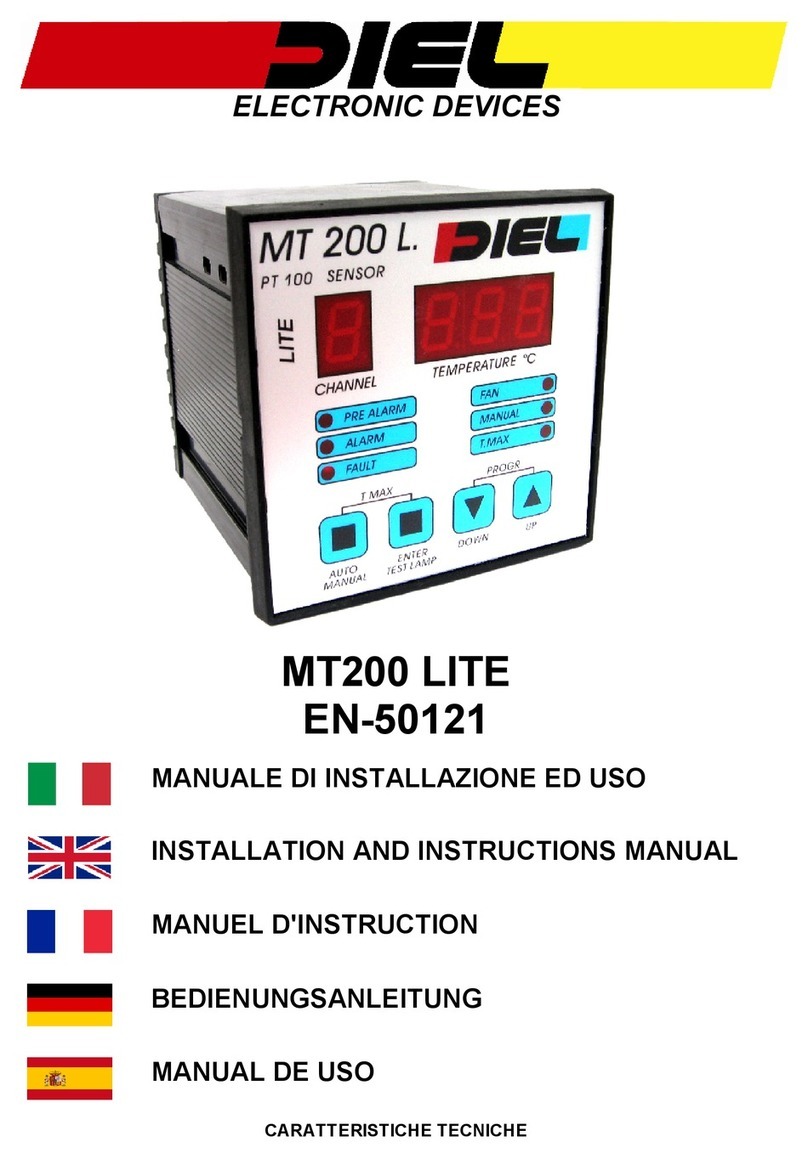
DIEL
DIEL MT200 LITE Installation and instruction manual
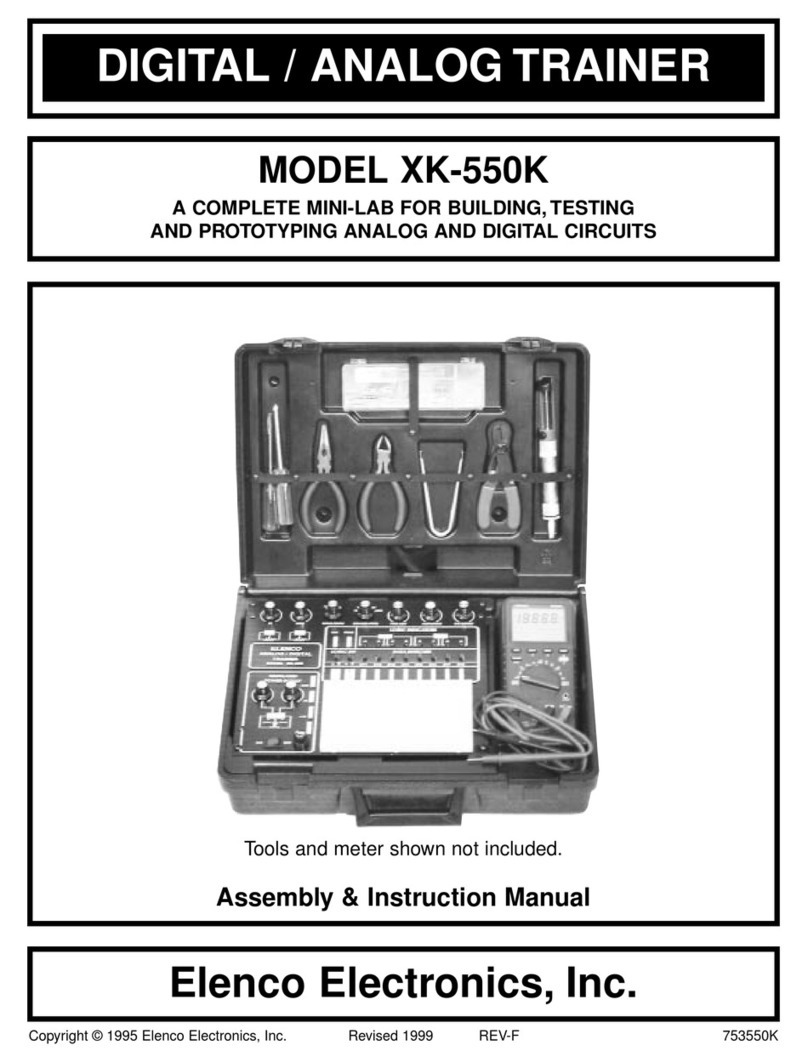
Elenco Electronics
Elenco Electronics XK-550K Assembly and instruction manual
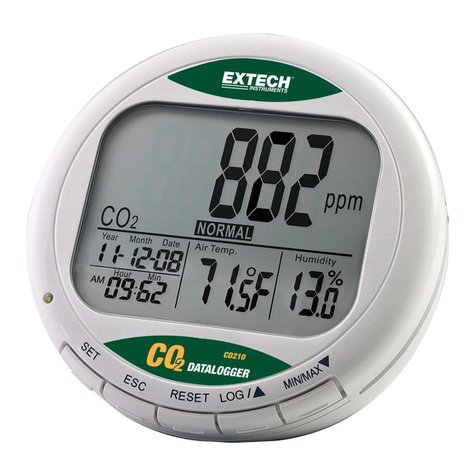
Extech Instruments
Extech Instruments CO210 user guide
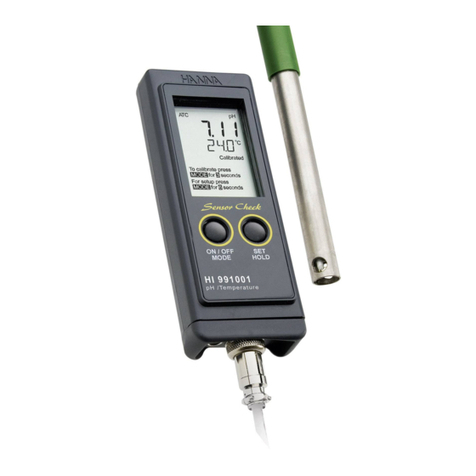
Hanna Instruments
Hanna Instruments HI 991001 instruction manual

Maxcess
Maxcess TIDLAND Installation, operation and maintenance

Dräger
Dräger X-AM 2500 Technical manual
